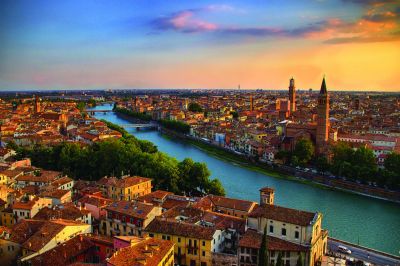Spring is here and the muddy fields after the torrential rain in February and early March are now looking green again. There are tiny shoots on the vines, and the hills are full of the most glorious wildflowers, especially the pale blue speedwell, known as ochiali della Madonna (Madonna’s eyes). Locals are out in the fields with scissors, cutting wild herbs to mix with ricotta for pasta fillings.
A couple of friends were staying in Milan, so we decided to meet them halfway and have a gossipy lunch in Verona. The trains were on time (not always the case!) and we wandered past the enormous Roman Arena to the Piazza del’Erbe, very lively with colorful market stalls and people wandering about, enjoying the spring sunshine.
I had booked a fabulous place for lunch, Al Pompieri, on a side street just off the square. It is an old-fashioned trattoria with walls full of old photographs and green checked tablecloths. The menu of course is seasonal: Italians don’t believe in eating out-of-season imported food. Now is the time for fat white asparagus, and I greatly enjoyed my warm asparagus salad followed by guinea fowl ravioli. My partner ate the curiously named Stinco, an enormous slow cooked leg of pork.
There is nothing nicer than wandering round the narrow picturesque streets of an Italian town, with small family-owned shops, cobbled streets and beautiful buildings all around. Verona has many fine churches, my favourite being Santa Anastasia with its 15th century fresco of St. George and the Dragon. Juliet’s house was besieged, as always, with people queuing to fondle her breasts on the statue beneath her balcony. It’s traditional to do this for luck. It rather undermines Shakespeare’s famous story! (Incidentally, the balcony isn’t genuine, but was added in the 1930s so that the scene from the balcony with Romeo beneath could be re-enacted.)
The Palazzo Maffei is a museum/art gallery in a prime position at one end of the main square. The art is a curious mixture of ultra-modern and minor 18th and 19th century Italian painters, but the view from its roof terrace is worth seeing, peering down between its life-size statues onto the Piazza below.
It was a terrific place to say our goodbyes and return in different directions across northern Italy.
https://www.lagazzettaitaliana.com/travel/10399-letters-from-veneto-a-day-in-verona#sigProId1e0d0fe794




